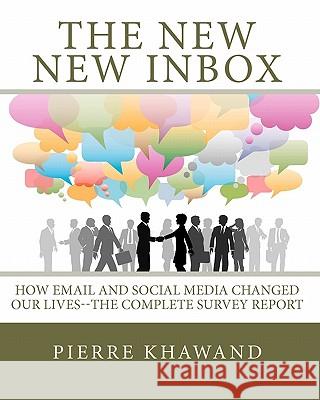The New New Inbox: How Email and Social Media Changed Our Lives--The Complete Survey Report » książka
The New New Inbox: How Email and Social Media Changed Our Lives--The Complete Survey Report
ISBN-13: 9781453768150 / Angielski / Miękka / 2010 / 226 str.
The New New Inbox: How Email and Social Media Changed Our Lives--The Complete Survey Report
ISBN-13: 9781453768150 / Angielski / Miękka / 2010 / 226 str.
(netto: 174,66 VAT: 5%)
Najniższa cena z 30 dni: 182,88
ok. 16-18 dni roboczych
Dostawa w 2026 r.
Darmowa dostawa!
We are caught in an e-mail vortex, a death-trap, and no one knows how to escape. Wait a minute Did I say e-mail? It is not only e-mail. It is now Facebook, LinkedIn, Twitter, blogs, YouTube, Google and Yahoo groups, RSS feeds of all kinds, Delicious bookmarks, and the list grows indefinitely. E-mail and Social Media have become resilient and ever-growing forces that continue to reshape our daily work and personal lives for better or worse. There is no end in sight These forces bring tremendous opportunities and yet incredible challenges. With all the excitement about these channels of communication we have delved deep into them and are now suffering from serious challenges that are leaving our workforce scattered and dis-oriented, and shrinking the bottom line. We have not yet mustered the wisdom and the tools to address these challenges and hone in on the opportunities. If you'd like to learn the in-depth story about how e-mail and Social Media are used in the workplace today, and what the future might hold, this survey report does just that. It closely analyzes the results of an extensive survey and draws valuable insights. It includes more than 300 color graphs and the most valuable data available on this topic. I designed this survey to explore further the impact that these platforms are having in the workplace and better qualify and quantify the underlying opportunities and challenges. The goal is to better understand the attitudes and behaviors of today's workforce as it relates to the use of e-mail and Social Media in the workplace, and to understand how these attitudes and behaviors vary by generation, by personality type, by function, and by company size. The survey identifies the platforms that are most in use and to what degree. It also pinpoints the time spent on e-mail and Social Media and how much of this time is spent on personal versus work-related activities. It also examines the tools that business professionals use to manage these platforms. Most importantly however, the survey identifies how strategic they are in using these platforms and therefore whether their efforts are aligned with their business goals. Finally, the survey explores interruptions and the extent to which these platforms contribute to interruptions and diminish our ability to focus on important tasks. 1000 business professionals participated in the survey. The largest segment (49.7% of the participants) is from organizations with 1000 or more employees, followed by participants from organizations with less than 1000 employees (28% of the participants), and then independent consultants and contractors (22.3% of the participants). The participants represented a broad range of industries. In terms of their functional areas within the organization, professional services, administrative, and marketing were the largest segments, followed by top management, product development, and sales. In terms of the generations, Gen X and Baby Boomers were the largest segments. This report presents the key findings from the survey as well as the details of the survey results shown by generation, by personality type, by function, and by company size.
Zawartość książki może nie spełniać oczekiwań – reklamacje nie obejmują treści, która mogła nie być redakcyjnie ani merytorycznie opracowana.











